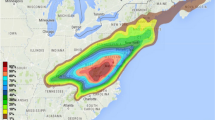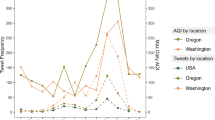Abstract
Social network services (SNSs) may benefit public health by augmenting surveillance and distributing information to the public. In this study, we collected Twitter data focusing on six different heat-related themes (air conditioning, cooling center, dehydration, electrical outage, energy assistance, and heat) for 182 days from May 7 to November 3, 2014. First, exploratory linear regression associated outdoor heat exposure to the theme-specific tweet counts for five study cities (Los Angeles, New York, Chicago, Houston, and Atlanta). Next, autoregressive integrated moving average (ARIMA) time series models formally associated heat exposure to the combined count of heat and air conditioning tweets while controlling for temporal autocorrelation. Finally, we examined the spatial and temporal distribution of energy assistance and cooling center tweets. The result indicates that the number of tweets in most themes exhibited a significant positive relationship with maximum temperature. The ARIMA model results suggest that each city shows a slightly different relationship between heat exposure and the tweet count. A one-degree change in the temperature correspondingly increased the Box-Cox transformed tweets by 0.09 for Atlanta, 0.07 for Los Angeles, and 0.01 for New York City. The energy assistance and cooling center theme tweets suggest that only a few municipalities used Twitter for public service announcements. The timing of the energy assistance tweets suggests that most jurisdictions provide heating instead of cooling energy assistance.







Similar content being viewed by others
References
Acar A, Muraki Y (2011) Twitter for crisis communication: lessons learned from Japan’s tsunami disaster. Int J Web Based Communities 7(3):392–402
Anderson GB, Bell ML (2011) Heat waves in the United States: mortality risk during heat waves and effect modification by heat wave characteristics in 43 US communities. Environ Health Perspect 119(2):210–218
Anderson GB, Bell ML (2012) Lights out: impact of the August 2003 power outage on mortality in New York, NY. Epidemiology 23(2):189–193
Aramaki E, Maskawa S, Morita M (2011) Twitter catches the flu: detecting influenza epidemics using Twitter. Proceedings of the 2011 Conference on Empirical Methods in Natural Language Processing 1568–1576
Armstrong B (2006) Models for the relationship between ambient temperature and daily mortality. Epidemiology 17(6):624–631
Austin BJ (2014) Perspectives of weather and sensitivities to heat: social media applications for cultural climatology. Dissertation, Kent State University
Baccini M, Biggeri A, Accetta G, Kosatsky T, Katsouyanni K, Analitis A, Anderson HR, Bisanti L, D’Ippoliti D, Danova J, Forsberg B, Medina S, Paldy A, Rabczenko D, Schindler C, Michelozzi P (2008) Heat effects on mortality in 15 European cities. Epidemiology 19(5):711–719
Basu R (2009) High ambient temperature and mortality: a review of epidemiologic studies from 2001 to 2008. Environ Health 8:40
Basu R, Samet JM (2002) Relation between elevated ambient temperature and mortality: a review of the epidemiologic evidence. Epidemiol Rev 24(2):190–202
Baylis P (2015) Temperature and temperament: evidence from a billion tweets. Energy Institute at HAAS working paper
Bernard SM, McGeehin MA (2004) Municipal heat wave response plans. Am J Public Health 94(9):1520–1522
Broniatowski DA, Paul MJ, Dredze M (2013) National and local influenza surveillance through Twitter: an analysis of the 2012-2013 influenza epidemic. PLoS One 8(12):e83672
Carson C, Hajat S, Armstrong B, Wilkinson P (2006) Declining vulnerability to temperature-related mortality in London over the 20th century. Am J Epidemiol 164(1):77–84
Chew C, Eysenbach G (2010) Pandemics in the age of Twitter: content analysis of tweets during the 2009 H1N1 outbreak. PLoS One 5(11):e14118
Conti S, Meli P, Minelli G, Solimini R, Toccaceli V, Vichi M, Beltrano C, Perini L (2005) Epidemiologic study of mortality during the summer 2003 heat wave in Italy. Environ Res 98(3):390–399
Culotta A (2010) Towards detecting influenza epidemics by analyzing Twitter messages. Proceedings of the First Workshop on Social Media Analytics 115–122
Curriero FC, Heiner KS, Samet JM, Zeget SL, Strug L, Patz JA (2002) Temperature and mortality in eleven cities of the eastern United States. Am J Epidemiol 155(1):80–87
Doan S, Vo BKH, Collier N (2011) An analysis of Twitter messages in the 2011 Tohoku earthquake. International Conference on Electronic Healthcare, vol 91. Springer, Berlin Heidelberg, pp 58–66
Duggan M, Brenner J (2013) The demographics of social media users—2012 (Vol. 14). Pew Research Center’s Internet & American Life Project, Washington, DC
Earle PS, Bowden DC, Guy M (2011) Twitter earthquake detection: earthquake monitoring in a social world. Ann Geophys 54(6):708–715
Gao Q, Abel F, Houben G-J, Yu Y (2012) A comparative study of users’ microblogging behavior on Sina Weibo and Twitter. International Conference on User Modeling, Adaptation, and Personalization. Springer Berlin Heidelberg 88–101
Garssen J, Harmsen C, De Beer J (2005) The effect of the summer 2003 heat wave on mortality in the Netherlands. Euro Surveill 10(7):165–167
Ginsberg J, Mohebbi MH, Patel RS, Brammer L, Smolinski MS, Brilliant L (2009) Detecting influenza epidemics using search engine query data. Nature 457:1012–1014
Golbeck J, Grimes J, Rogers A (2010) Twitter use by the US congress. J Am Soc Inf Sci Tec 61(8):1612–1621
Gosselin C, Kosatsky T, Fournier M, Richard L, Pinard M, King N, Bonney D, Gaudet J (2009) Evaluation of the education campaign on health risks associated with heat waves and on related protection measures. Directeur de Santé Publique de Montréal, Montréal
Hajat S, Armstrong B, Baccini M, Biggeri A, Bisanti L, Russo A, Paldy A, Menne B, Kosatsky T (2006) Impact of high temperatures on mortality: is there an added heat wave effect? Epidemiology 17(6):632–638
Harris JK, Snider D, Mueller N (2013) Social media adoption in health departments nationwide: the state of the states. Front Public Health Serv Syst Res 2(1):5
Heffernan R, Mostashari F, Das D, Karpati A, Kulldorff M, Weiss D (2004) Syndromic surveillance in public health practice, New York City. Emerg Infect Dis 10(5):858–864
Huang W, Kan H, Kovats S (2010) The impact of the 2003 heat wave on mortality in Shanghai, China. Sci Total Environ 408(11):2418–2420
Kilbourne EM (1997) Heat waves and hot environments. The public health consequences of disasters 245–269
King D, Ramirez-Cano D, Greaves F, Vlaev I, Beales S, Darzi A (2013) Twitter and the health reforms in the English National Health Service. Health policy 110(2):291–297
Klinenberg E (2003) Heat wave: a social autopsy of disaster in Chicago. U of Chicago Press, Chicago
Knowlton K, Rotkin-Ellman M, King G, Margolis HG, Smith D, Solomon G, Trent R, English P (2009) The 2006 California heat wave: impacts on hospitalizations and emergency department visits. Environ Health Perspect 117(1):61–67
Kovats RS, Ebi KL (2006) Heatwaves and public health in Europe. Eur J Pub Health 16(6):592–599
Lane K, Wheeler K, Charles-Guzman K, Ahmed M, Blum M, Gregory K, Graber N, Clark N, Matte T (2014) Extreme heat awareness and protective behaviors in New York City. J Urban Health 91(3):403–414
Li J, Wang X, Hovy E (2014) What a nasty day: exploring mood-weather relationship from Twitter. Proceedings of the 23rd ACM International Conference on Information and Knowledge Management 1309–1318
Lin S, Luo M, Walker RJ, Liu X, Hwang S-A, Chinery R (2009) Extreme high temperatures and hospital admissions for respiratory and cardiovascular diseases. Epidemiology 20(5):738–746
Luber G, McGeehin M (2008) Climate change and extreme heat events. Am J Prev Med 35(5):429–435
Mandel B, Culotta A, Boulahanis J, Stark D, Lewis B, Rodrigue J (2012) A demographic analysis of online sentiment during hurricane Irene. Proceedings of the 2012 Workshop on Language in Social Media, Assoc Comput Linguist 27–36
Meehl GA, Tebaldi C (2004) More intense, more frequent, and longer lasting heat waves in the twenty-first century. Science 305:994–997
Michelozzi P, Accetta G, De Sario M, D’Ippoliti D, Marino C, Baccini M, Biggeri A, Anderson HR, Katsouyanni K, Ballester F, Bisanti L, Cadum E, Forsberg B, Forastiere F, Goodman PG, Hojs A, Kirchmayer U, Medina S, Paldy A, Schindler C, Sunyer J, Perucci CA (2009) High temperature and hospitalizations for cardiovascular and respiratory causes in 12 European cities. Am J Respir Crit Care Med 179(5):383–389
National Center for Appropriate Technology (NCAT) (2015) LIHEAP program duration: heating, cooling, and crisis. https://liheapch.acf.hhs.gov/tables/FY2015/dates.htm. Accessed 10 Sep 2016
Naughton MP, Henderson A, Mirabelli MC, Mirabelli MC, Kaiser R, Wilhelm JL, Kieszak SM, Rubin CH, McGeehin MA (2002) Heat-related mortality during a 1999 heat wave in Chicago. Am J Prev Med 22(4):221–227
O’Neill MS, Zanobetti A, Schwartz J (2005) Disparities by race in heat-related mortality in four US cities: the role of air conditioning prevalence. J Urban Health 82(2):191–197
Ostro B, Rauch S, Green R, Malig B, Basu R (2010) The effects of temperature and use of air conditioning on hospitalizations. Am J Epidemiol 172(9):1053–1061
Palecki MA, Changnon SA, Kunkel KE (2001) The nature and impacts of the July 1999 heat wave in the midwestern United States: learning from the lessons of 1995. Bull Am Met Soc 82(7):1353–1367
Perl L (2013) LIHEAP: program and funding. Technical report, Congressional Research Service
Saez M, Sunyer J, Castellsague J, Murillo C, Anto JM (1995) Relationship between weather temperature and mortality: a time series analysis approach in Barcelona. Int J Epidemiol 24(3):576–582
Sakaki T, Okazaki M, Matsuo Y (2010) Earthquake shakes Twitter users: real-time event detection by social sensors. Proceedings of the 19th International Conference on World Wide Web
Semenza JC, Rubin CH, Falter KH, Selanikio JD, Flanders WD, Howe HL, Wilhelm JL (1996) Heat-related deaths during the July 1995 heat wave in Chicago. N Engl J Med 335(2):84–90
Sheridan SC (2002) The redevelopment of a weather-type classification scheme for North America. Int J Climatol 22:51–68
Sheridan SC (2007) A survey of public perception and response to heat warnings across four North American cities: an evaluation of municipal effectiveness. Int J Biometeorol 52(1):3–15
Sheridan SC, Kalkstein LS (2004) Progress in heat watch-warning system technology. Bull Am Met Soc 85(12):1931–1941
Signorini A, Segre AM, Polgreen PM (2011) The use of Twitter to track levels of disease activity and public concern in the US during the influenza A H1N1 pandemic. PLoS One 6(5):e19467
Sloan L, Morgan J, Burnap P, Williams M (2015) Who tweets? Deriving the demographic characteristics of age, occupation and social class from Twitter user meta-data. PLoS One 10(3):e0115545
Takahashi B, Tandoc EC, Carmichael C (2015) Communicating on Twitter during a disaster: an analysis of tweets during Typhoon Haiyan in the Philippines. Comput Hum Behav 50:392–398
Thom EC (1959) The discomfort index. Weatherwise 12:57–60
Tonn B, Eisenberg J (2007) The aging US population and residential energy demand. Energy Policy 35(1):743–745
Uejio CK, Wilhelmi OV, Golden JS, Mills DM, Gulino SP, Samenow JP (2011) Intra-urban societal vulnerability to extreme heat: the role of heat exposure and the built environment, socioeconomics, and neighborhood stability. Health Place 17(2):498–507
United States Census Bureau estimates (2015) Available at: http://www.census.gov/popest/data/cities/totals/2015/index.html. Accessed June 20, 2016
Vaneckova P, Beggs PJ, de Dear RJ, McCracken KWJ (2008) Effect of temperature on mortality during the six warmer months in Sydney, Australia, between 1993 and 2004. Environ Res 108(3):361–369
West JH, Hall PC, Prier K, Hanson CL, Giraud-Carrier C, Neeley ES, Barnes MD (2012) Temporal variability of problem drinking on Twitter. Open J Prev Med 2(1):43–48
Zhang L (2013) Sentiment analysis on Twitter with stock price and significant keyword correlation. Dissertation, University of Texas
Acknowledgements
This publication was developed under Assistance Agreement (RD no. 83574901) awarded by the US Environmental Protection Agency to Christopher K. Uejio. It has not been formally reviewed by the EPA. The views expressed in this document are solely those of the authors and do not necessarily reflect those of the agency. EPA does not endorse any products or commercial services mentioned in this publication.
Author information
Authors and Affiliations
Corresponding author
Electronic supplementary material
ESM 1
(DOCX 1322 kb)
Rights and permissions
About this article
Cite this article
Jung, J., Uejio, C.K. Social media responses to heat waves. Int J Biometeorol 61, 1247–1260 (2017). https://doi.org/10.1007/s00484-016-1302-0
Received:
Revised:
Accepted:
Published:
Issue Date:
DOI: https://doi.org/10.1007/s00484-016-1302-0




